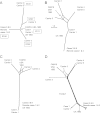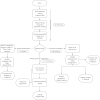Resolution of a meningococcal disease outbreak from whole-genome sequence data with rapid Web-based analysis methods
- PMID: 22785191
- PMCID: PMC3421817
- DOI: 10.1128/JCM.01312-12
Resolution of a meningococcal disease outbreak from whole-genome sequence data with rapid Web-based analysis methods
Abstract
The increase in the capacity and reduction in cost of whole-genome sequencing methods present the imminent prospect of such data being used routinely in real time for investigations of bacterial disease outbreaks. For this to be realized, however, it is necessary that generic, portable, and robust analysis frameworks be available, which can be readily interpreted and used in real time by microbiologists, clinicians, and public health epidemiologists. We have achieved this with a set of analysis tools integrated into the PubMLST.org website, which can in principle be used for the analysis of any pathogen. The approach is demonstrated with genomic data from isolates obtained during a well-characterized meningococcal disease outbreak at the University of Southampton, United Kingdom, that occurred in 1997. Whole-genome sequence data were collected, de novo assembled, and deposited into the PubMLST Neisseria BIGSdb database, which automatically annotated the sequences. This enabled the immediate and backwards-compatible classification of the isolates with a number of schemes, including the following: conventional, extended, and ribosomal multilocus sequence typing (MLST, eMLST, and rMLST); antigen gene sequence typing (AGST); analysis based on genes conferring antibiotic susceptibility. The isolates were also compared to a reference isolate belonging to the same clonal complex (ST-11) at 1,975 loci. Visualization of the data with the NeighborNet algorithm, implemented in SplitsTree 4 within the PubMLST website, permitted complete resolution of the outbreak and related isolates, demonstrating that multiple closely related but distinct strains were simultaneously present in asymptomatic carriage and disease, with two causing disease and one responsible for the outbreak itself.
Figures




Similar articles
-
Surveillance of invasive meningococcal disease based on whole genome sequencing (WGS), Czech Republic, 2015.Epidemiol Mikrobiol Imunol. 2018 Spring;67(2):64-73. Epidemiol Mikrobiol Imunol. 2018. PMID: 30126283 English.
-
Whole genome typing of the recently emerged Canadian serogroup W Neisseria meningitidis sequence type 11 clonal complex isolates associated with invasive meningococcal disease.Int J Infect Dis. 2018 Apr;69:55-62. doi: 10.1016/j.ijid.2018.01.019. Epub 2018 Feb 4. Int J Infect Dis. 2018. PMID: 29414677
-
Genomic comparative analysis and gene function prediction in infectious diseases: application to the investigation of a meningitis outbreak.BMC Infect Dis. 2013 Nov 19;13:554. doi: 10.1186/1471-2334-13-554. BMC Infect Dis. 2013. PMID: 24252229 Free PMC article.
-
Automated extraction of typing information for bacterial pathogens from whole genome sequence data: Neisseria meningitidis as an exemplar.Euro Surveill. 2013 Jan 24;18(4):20379. doi: 10.2807/ese.18.04.20379-en. Euro Surveill. 2013. PMID: 23369391 Free PMC article. Review.
-
Neisseria meningitidis; clones, carriage, and disease.Clin Microbiol Infect. 2014 May;20(5):391-5. doi: 10.1111/1469-0691.12647. Clin Microbiol Infect. 2014. PMID: 24766477 Review.
Cited by
-
Clinical detection and characterization of bacterial pathogens in the genomics era.Genome Med. 2014 Nov 29;6(11):114. doi: 10.1186/s13073-014-0114-2. eCollection 2014. Genome Med. 2014. PMID: 25593594 Free PMC article.
-
Genomic Analysis of Serogroup Y Neisseria meningitidis Isolates Reveals Extensive Similarities Between Carriage-Associated and Disease-Associated Organisms.J Infect Dis. 2016 Jun 1;213(11):1777-85. doi: 10.1093/infdis/jiw008. Epub 2016 Jan 7. J Infect Dis. 2016. PMID: 26747709 Free PMC article.
-
Bacterial genomes in epidemiology--present and future.Philos Trans R Soc Lond B Biol Sci. 2013 Feb 4;368(1614):20120202. doi: 10.1098/rstb.2012.0202. Print 2013 Mar 19. Philos Trans R Soc Lond B Biol Sci. 2013. PMID: 23382424 Free PMC article. Review.
-
An OMV Vaccine Derived from a Capsular Group B Meningococcus with Constitutive FetA Expression: Preclinical Evaluation of Immunogenicity and Toxicity.PLoS One. 2015 Sep 21;10(9):e0134353. doi: 10.1371/journal.pone.0134353. eCollection 2015. PLoS One. 2015. PMID: 26390123 Free PMC article.
-
Genome sequence analyses show that Neisseria oralis is the same species as 'Neisseria mucosa var. heidelbergensis'.Int J Syst Evol Microbiol. 2013 Oct;63(Pt 10):3920-3926. doi: 10.1099/ijs.0.052431-0. Int J Syst Evol Microbiol. 2013. PMID: 24097834 Free PMC article.
References
-
- Bentley SD, et al. 2007. Meningococcal genetic variation mechanisms viewed through comparative analysis of serogroup C strain FAM18. PLoS Genet. 3:e23 doi:10.1371/journal.pgen.003023 - DOI - PMC - PubMed
Publication types
MeSH terms
Grants and funding
LinkOut - more resources
Full Text Sources
Other Literature Sources
Medical
Molecular Biology Databases

